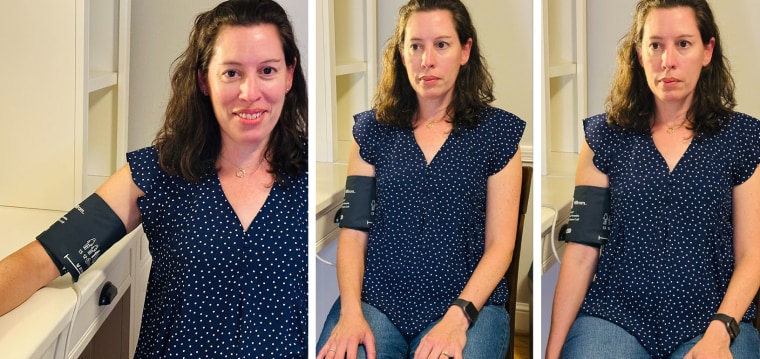[ad_1]
Blood pressure readings may not be accurate unless a person’s arm is positioned correctly, a new study suggests.
A comparison of blood pressure readings taken while people held their arms three different ways — leaning on a surface, resting on the lap or hanging by the side of the body — showed certain positions could lead to a significant increase in systolic pressure, the upper number in a blood pressure reading, according to the study published Monday in JAMA Internal Medicine. Systolic refers to the amount of pressure in a person’s arteries, when the heart sends blood throughout the body.
The size of the difference, nearly 7 points in the arm dangling position, was a surprise, said the study’s senior author, Dr. Tammy Brady, a pediatrician and epidemiologist and medical director of the pediatric hypertension program at the Johns Hopkins Children’s Center.

The researchers weren’t sure what to expect prior to running their experiment. “There was a chance that arm position was not important,” she said.
“One of my hopes is that this will help inform patients as to how to do this on their own and also to tell their health care provider the right way,” Brady said. “Patients should be empowered to make sure the blood pressure measurement is accurate.”
The American Heart Association recommends that a patient’s arm should be supported to get an accurate reading. The guidelines also say:
- Avoid caffeine, exercise and smoking for 30 minutes.
- The blood pressure cuff should be positioned at mid-heart level.
- The patient’s feet should be flat on the floor, with the back supported.
Nearly half of U.S. adults have high blood pressure, which occurs when the measured force of blood flowing through blood vessels is higher than what is considered normal: less than 120 systolic pressure and less than 80 diastolic. Diastolic is the pressure in the arteries between heart beats. Hypertension often causes minimal symptoms but untreated it can increase the risk for stroke, heart attack and other serious cardiovascular conditions.
To learn whether arm position made a difference in blood pressure readings, Brady and her colleagues recruited 133 adults, 78% of them Black and 52% female. The study volunteers’ ages ranged from 18 to 80.
While all the participants had blood pressure measured in each of the three arm positions, they were randomly assigned to one of six possible groups that differed by the order in which the positions were assumed.
The researchers found that when people had their arms hanging by their sides during the reading, their systolic pressure was 6.5 points higher than when their arms were resting on a desk, while the diastolic blood pressure — the bottom number — was 4.4 points higher than in the supported condition.
Similarly when people’s arms were on their laps, the systolic blood pressure was 3.9 points higher than when their arms were supported by a surface, while the diastolic pressure was 4 points higher than in the supported condition.
Those differences can lead to more diagnoses of hypertension and patients being prescribed medications they don’t need
For example, if a person’s actual blood pressure is 134, and blood pressure is measured on a dangling arm, the reading could end up over 140, which is considered to be stage 2 hypertension.
Mispositioning of a patient’s arm “unfortunately is a common experience,” said Dr. Karyn Singer, an assistant professor of medicine at New York University and assistant vice president of chronic disease and prevention at NYC Health + Hospitals. “As a patient, I’ve been there.”
The study provides a “piece of evidence that is really critical,” said Singer, who was not affiliated with the new research. “Until now it hasn’t been clear how much arm position changes blood pressure readings.”
Singer’s main message for patients: “Be aware of the proper blood pressure measuring technique and to advocate for themselves if they think the blood pressure reading is higher than they think it should be.”
As a patient, Dr. Megan Kamath has also had similar experiences at different health care settings and different offices.
“There is a pretty significant difference in blood pressure readings depending on arm position,” said Kamath, a cardiologist at UCLA Health.
“This is a fascinating study,” said Kamath, who was not involved with the research. “What I took from reading it was, wow, with a simple study design these researchers found some important real world implications that can make the difference between a patient being treated for hypertension or not.”
Patients who receive blood pressure lowering medication that they don’t need may experience side effects, such as lightheadedness, dizziness, fatigue and blurry vision, Singer said.
Dr. Matthew Tomey, a cardiologist at Mount Sinai Fuster Heart Hospital in New York City, said the findings support a patient asking for a doctor to measure blood pressure the “right way.”
The differences found by the researchers can be enough to move someone from one blood pressure category to another, said Tomey, who was not part of the new study.
[ad_2]
Source link
Share this content:
